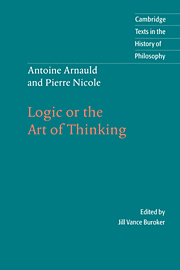Book contents
- Frontmatter
- Contents
- Acknowledgments
- Introduction
- Chronology
- Further reading
- List of works cited in the text and notes
- Note on the text and translation
- Logic or the Art of Thinking
- Preface
- Foreword
- First discourse
- Second discourse
- First part, containing reflections on ideas
- Second part of the Logic, containing reflections people have made about their judgments
- Third part of the Logic, on reasoning
- Fourth part of the Logic, on method
- Index
- Cambridge texts in the history of philosophy
Introduction
Published online by Cambridge University Press: 05 June 2012
- Frontmatter
- Contents
- Acknowledgments
- Introduction
- Chronology
- Further reading
- List of works cited in the text and notes
- Note on the text and translation
- Logic or the Art of Thinking
- Preface
- Foreword
- First discourse
- Second discourse
- First part, containing reflections on ideas
- Second part of the Logic, containing reflections people have made about their judgments
- Third part of the Logic, on reasoning
- Fourth part of the Logic, on method
- Index
- Cambridge texts in the history of philosophy
Summary
La Logique ou l'art de penser, better known as the Port-Royal Logic, was written by Antoine Arnauld and Pierre Nicole. Arnauld and Nicole were philosophers and theologians associated with the Port-Royal Abbey, a center of the Catholic Jansenist movement in seventeenth–century France. The first edition of the Logic appeared in 1662; during the authors' lifetimes four major revisions were published, the last and most important in 1683. This work is a companion to General and Rational Grammar: The Port-Royal Grammar, written primarily by Arnauld and “edited” by Claude Lancelot, which appeared two years before the Logic. The Logic incorporates some theory from the Grammar, but develops an account of knowledge and meaning of much greater scope and richness. The Grammar is important because it represents a classical “rational” account of language as opposed to recent behavioristic theories. In the last twenty-five years it has received renewed attention, largely due to Noam Chomsky's claims in Cartesian Linguistics and elsewhere that it prefigured modern transformational generative grammar. For example, Arnauld and Lancelot recognize that the “surface structure” of a sentence (the organization of the written or spoken sentence) need not mirror its “deep structure” (the aspects relevant to semantic interpretation). There are, however, reasons to question how systematically or self-consciously the Grammar develops this view, as well as whether the theory contains other features required to classify it as a transformational generative grammar.
- Type
- Chapter
- Information
- Antoine Arnauld and Pierre Nicole: Logic or the Art of Thinking , pp. ix - xxviPublisher: Cambridge University PressPrint publication year: 1996



